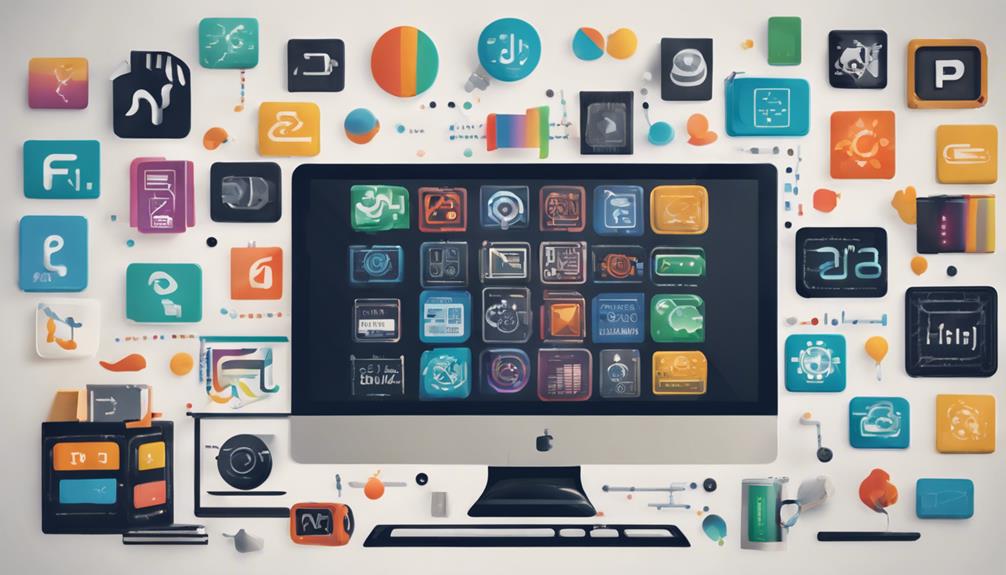In a world where images speak volumes, the applications of image data processing are both intriguing and essential for modern advancements. From unraveling the mysteries of medical imaging to optimizing agricultural practices, the possibilities seem limitless. But have you ever pondered the intricate ways in which image data processing is revolutionizing virtual reality experiences and shaping the future of machine vision? These 12 fascinating applications will shed light on the profound impact of this technology across various domains, sparking a curiosity to explore further.
Medical Imaging
In medical imaging, images of the body are processed and analyzed to assist in diagnosis and treatment planning. Diagnostic accuracy is paramount in healthcare, and image segmentation techniques play a crucial role in achieving this. By segmenting an image, you can identify and isolate different structures or regions within the body, aiding in the accurate diagnosis of various conditions.
Image segmentation techniques involve partitioning an image into multiple segments to simplify its representation. This process allows healthcare professionals to precisely locate areas of interest, such as tumors or abnormalities, within the image. The ability to segment images effectively enhances diagnostic accuracy by providing detailed insights into the patient’s condition.
Furthermore, advanced algorithms have been developed to automate the segmentation process, reducing the time and effort required for analysis. These algorithms utilize machine learning and artificial intelligence to improve the efficiency and accuracy of medical image analysis, ultimately benefiting patient care and treatment outcomes.
Remote Sensing
Utilizing image data processing techniques beyond the medical field, remote sensing involves the analysis of images captured from a distance to gather information about the Earth’s surface and atmosphere. Remote sensing plays a crucial role in environmental monitoring by providing valuable data on ecosystems, deforestation, and climate change. It aids in disaster management by enabling quick assessment of affected areas during natural calamities such as floods, wildfires, and earthquakes.
In urban planning, remote sensing is instrumental in analyzing land use patterns, infrastructure development, and population distribution. By utilizing satellite imagery and aerial photographs, urban planners can make informed decisions regarding city expansion, transportation networks, and green space allocation.
Furthermore, remote sensing technologies offer a cost-effective and efficient way to monitor environmental changes over large areas, helping policymakers implement sustainable practices and mitigate potential risks. With its diverse applications in environmental monitoring, disaster management, urban planning, and land use analysis, remote sensing continues to be a valuable tool for understanding and managing our planet’s dynamic landscapes.
Computer Vision
Implementing advanced algorithms, computer vision enables machines to interpret and analyze visual information from images and videos. Through the power of deep learning, computer vision has revolutionized various industries by automating tasks that traditionally required human intervention. Image classification is a crucial aspect of computer vision, where algorithms categorize images into different classes based on their content.
- Enhanced Accuracy: Deep learning models in computer vision have significantly improved accuracy in image classification tasks compared to traditional methods.
- Real-Time Processing: Computer vision algorithms can process images and videos in real-time, enabling applications like facial recognition and augmented reality to function seamlessly.
- Object Detection: Beyond image classification, computer vision also encompasses object detection, allowing machines to identify and locate multiple objects within an image.
- Semantic Segmentation: This technique in computer vision assigns a label to each pixel in an image, enabling more detailed scene understanding and analysis.
Robotics
Advanced robotics technology integrates complex mechanical systems with intelligent algorithms, enhancing automation and precision in various industries. Robot navigation plays a crucial role in enabling robots to move autonomously within their environment. By utilizing image data processing techniques such as simultaneous localization and mapping (SLAM), robots can create maps of their surroundings and localize themselves in real-time. This capability is essential for tasks like warehouse automation, where robots need to navigate through dynamic environments efficiently.
Object manipulation is another key aspect where image data processing comes into play. Robots equipped with advanced vision systems can identify objects, determine their position and orientation, and manipulate them with precision. This is particularly valuable in industries like manufacturing, where robots handle delicate components or execute intricate assembly processes.
Security Systems
Image data processing plays a pivotal role in enhancing the capabilities of security systems, enabling efficient surveillance and threat detection in diverse environments. The integration of advanced algorithms with surveillance cameras has revolutionized the field of security, providing real-time monitoring and analysis of vast amounts of visual data. Identity verification has also significantly benefited from image data processing, allowing for accurate recognition and authentication of individuals even in crowded or challenging scenarios.
- Improved Surveillance: Surveillance cameras equipped with image data processing can automatically detect suspicious activities and alert security personnel promptly.
- Enhanced Threat Detection: Image data processing algorithms can identify potential threats by analyzing patterns and anomalies in the visual data captured by security cameras.
- Facial Recognition: Identity verification systems utilize image data processing to match faces with existing databases, aiding in the identification of individuals in real-time.
- Access Control: Security systems can use image data processing to regulate entry to restricted areas by verifying identities through facial or biometric recognition technologies.
Autonomous Vehicles
The integration of sophisticated algorithms in autonomous vehicles has revolutionized the transportation industry, paving the way for innovative advancements in self-driving technology. Traffic management is greatly enhanced through real-time data processing, enabling autonomous vehicles to navigate complex road systems efficiently. Obstacle detection algorithms play a crucial role in ensuring the safety of passengers and pedestrians by swiftly identifying and responding to potential hazards on the road.
Moreover, autonomous vehicles equipped with human behavior analysis capabilities can predict and react to the movements of drivers and pedestrians, further enhancing overall road safety. Road sign recognition technology allows these vehicles to interpret and respond to traffic signs accurately, ensuring compliance with traffic regulations.
Photography
You can explore the cutting-edge world of photography through image enhancement techniques that elevate the quality of your pictures to new heights. Facial recognition technology opens up a realm of possibilities, allowing for efficient organization and categorization of photos based on people’s faces. Additionally, image metadata extraction provides valuable insights by revealing hidden information embedded within the visual data.
Image Enhancement Techniques
Enhancing photographs involves applying various digital tools and techniques to improve the overall quality and visual appeal of the image. When it comes to image enhancement, tasks such as noise reduction and color correction play a crucial role in refining the final output.
- Noise Reduction: Eliminating unwanted noise from images can significantly enhance clarity and sharpness, resulting in a cleaner and more professional look.
- Color Correction: Adjusting colors can make images more vibrant and true to life, ensuring that the visual representation aligns with the intended mood or message.
- Sharpening: Enhancing the sharpness of an image can bring out finer details and textures, making it visually engaging and captivating.
- Contrast Adjustment: Tweaking the contrast levels can help in improving the overall tonal range, adding depth and dimension to the image.
Facial Recognition Technology
By utilizing advanced algorithms, facial recognition technology in photography enables the identification and analysis of human faces within digital images. This technology has revolutionized the way we interact with photos, offering features such as emotion detection and age estimation. Emotion detection algorithms can analyze facial expressions to determine the emotional state of individuals in an image, providing valuable insights for various applications, from market research to security systems. Age estimation algorithms utilize facial features to predict the age of individuals in photos, which can be useful in personalized marketing campaigns or age-restricted content filtering.
However, the widespread adoption of facial recognition technology raises concerns about privacy and ethical implications. The ability to track and identify individuals through photos has sparked debates about data security and consent. Privacy concerns are particularly significant in public spaces where facial recognition is used for surveillance purposes. Addressing these ethical dilemmas is crucial to ensure the responsible development and deployment of facial recognition technology in photography.
Image Metadata Extraction
Image metadata extraction in photography involves the process of retrieving and analyzing hidden data embedded within digital images. This extraction is crucial for various applications, ranging from image classification to data analysis. Here are some key points to consider:
- Image Classification: Metadata extraction aids in categorizing images based on specific criteria, allowing for efficient organization and retrieval of visual data.
- Data Analysis: Extracted metadata provides valuable insights for data analysis, allowing photographers to understand patterns and trends within their image collections.
- Image Segmentation: By extracting metadata, photographers can segment and group images based on common attributes, facilitating targeted analysis and editing.
- Feature Extraction: Metadata extraction enables the extraction of specific features from images, which can be used for various purposes such as content-based image retrieval and image enhancement techniques.
Facial Recognition
Utilizing advanced algorithms, facial recognition technology has revolutionized security systems and personal device authentication methods. The ability to accurately identify individuals based on facial features has led to significant advancements in various industries. However, the widespread adoption of facial recognition also raises privacy concerns and ethical implications.
Privacy concerns stem from the potential misuse of facial recognition data, such as unauthorized surveillance or tracking individuals without their consent. Ethical considerations come into play regarding the collection and storage of facial data, as well as the potential for bias in recognition algorithms.
Despite these challenges, facial recognition technology continues to evolve, offering improved accuracy and efficiency. Its applications range from law enforcement and border control to unlocking smartphones and enhancing customer experiences in retail settings. As the technology progresses, addressing privacy and ethical issues will be crucial to ensure its responsible and beneficial use in society.
Agriculture
Enhancing crop yield and quality through advanced image data processing techniques has become a pivotal focus in modern agricultural practices. By utilizing image data processing, farmers can revolutionize the way they approach crop monitoring, yield optimization, soil analysis, and disease detection.
- Crop Monitoring: Image data processing enables real-time monitoring of crops, allowing farmers to track growth patterns, detect anomalies, and make informed decisions to enhance productivity.
- Yield Optimization: Through image data analysis, farmers can identify areas of improvement in crop cultivation practices, leading to increased yields and improved efficiency.
- Soil Analysis: Image processing techniques provide valuable insights into soil composition, nutrient levels, and moisture content, empowering farmers to optimize fertilization and irrigation strategies.
- Disease Detection: By analyzing images of plants, farmers can detect early signs of diseases or pest infestations, enabling prompt action to prevent widespread crop damage.
Incorporating image data processing in agriculture not only enhances productivity but also promotes sustainable farming practices by enabling precise interventions based on data-driven insights.
Digital Marketing
Implementing cutting-edge data processing techniques in digital marketing revolutionizes the way businesses analyze consumer behavior and optimize their online campaigns. By utilizing image data processing, marketers can extract valuable insights from social media platforms, enabling them to understand trends, sentiments, and preferences among their target audience. This data-driven approach allows for targeted advertising, personalized content, and strategic decision-making based on real-time analytics.
One key benefit of image data processing in digital marketing is its ability to enhance brand recognition. Through image recognition technology, companies can monitor the usage of their logos and products across various online channels, ensuring brand consistency and identifying opportunities for engagement. By analyzing visual content on social media, businesses can also track user-generated images related to their brand, gaining valuable feedback and shaping their marketing strategies accordingly.
Virtual Reality
Image data processing techniques have also found significant applications in the realm of Virtual Reality (VR), revolutionizing the way users interact with immersive digital environments. VR technology leverages image data processing to create lifelike simulations that transport users to entirely new worlds. Here’s why this application is crucial:
- Immersive Experiences: Image data processing enhances VR by providing high-resolution visuals and realistic textures, making the virtual environment feel more authentic.
- Interactive Simulations: Through image data processing, VR applications can respond to user input in real-time, allowing for dynamic and engaging interactive experiences.
- Spatial Awareness: Techniques such as depth perception and object recognition improve spatial awareness in VR environments, enhancing the sense of presence for users.
- User Engagement: By utilizing image data processing, VR can offer users a more captivating and interactive experience, increasing engagement and immersion in the virtual world.
Machine Vision
Utilizing advanced algorithms and hardware systems, machine vision processes visual data to extract meaningful information for various industrial and commercial applications. In the realm of industrial automation, machine vision plays a vital role in enhancing efficiency and accuracy. By analyzing images captured from production lines, machine vision systems can identify defects in real-time, contributing to improved quality control processes in manufacturing.
Manufacturing processes benefit greatly from machine vision technology, as it enables automated inspection and defect detection at a rapid pace. Through the utilization of machine vision systems, manufacturers can streamline their operations, reduce errors, and ensure that only products meeting specific quality standards are passed along the production line. This not only enhances overall quality assurance but also helps in minimizing costs associated with faulty products reaching the market.
Frequently Asked Questions
Can Image Data Processing Be Used for Weather Forecasting?
Yes, image data processing can revolutionize weather forecasting. By analyzing vast image datasets, you can enhance accuracy in predicting weather patterns. This technology benefits agricultural monitoring and disaster management by providing real-time insights for proactive decision-making.
How Does Image Data Processing Contribute to Wildlife Conservation Efforts?
In wildlife conservation efforts, image data processing plays a crucial role. It aids in biodiversity monitoring, habitat analysis, poaching detection, and wildlife population estimation. By analyzing vast amounts of visual data, it provides valuable insights for effective conservation strategies.
Can Image Data Processing Assist in Analyzing Historical Artworks?
Yes, image data processing can aid in analyzing historical artworks. It enables detailed examination for art restoration, revealing hidden layers and damages. Additionally, it assists in artistic style analysis, offering insights into techniques and influences.
Is Image Data Processing Being Used in Sports Analytics?
In sports analytics, image data processing revolutionizes player tracking for performance analysis. It enhances game strategy and aids in injury prevention. With cutting-edge technology, teams gain a competitive edge by decoding visual data intricacies.
How Does Image Data Processing Impact Fashion Design and Trends?
In fashion design and trends, image data processing revolutionizes color analysis for trend prediction, enhancing pattern recognition. Virtual fitting rooms offer personalized experiences, reshaping how consumers interact with clothing online, driving innovation and efficiency in the industry.



